Notice: Undefined variable: page in /home/vrxdg1855sn3/public_html/wp-content/themes/72tree/content.php on line 15
Notice: Trying to get property 'ID' of non-object in /home/vrxdg1855sn3/public_html/wp-content/themes/72tree/content.php on line 15
Why Do Trees Die
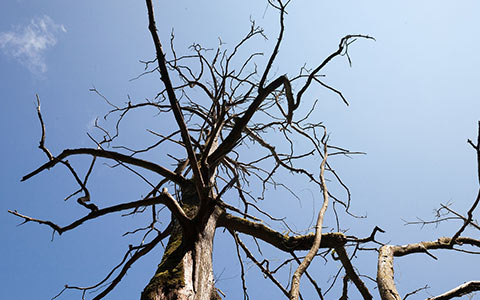
Prevent the environment, disease, and insect activity from killing your trees. Knowing why trees die will help you take notice and intervene on threats to your tree’s life.
72tree.com assembled the following information about the many factors that lead to the death of trees, the signs and symptoms of a dying tree, and what to do about it.
1. Tree Diseases
Tree diseases can wreak havoc on your trees, and in some instances, kill them in a single growing season. The following are some of the more common diseases that infect trees:
• Anthracnose (Glomerella cingulata)
• Fire Blight (Erwinia amylovora)
• Diplodia Tip Blight (Sphaeropsis sapinea)
• Oak Wilt (Ceratocystis fagacearum)
• Dutch Elm Disease (Ophiostoma ulmi)
• Canker Diseases (caused by multiple fungal pathogens)
Signs and Symptoms – Trees infected with different diseases will display different symptoms. However, all should be treated with haste to prevent the decline and death of the infected tree. The following symptoms can help you diagnose the disease you are dealing with
• Anthracnose – Sunken spots or lesions of various colors in foliage, stems, fruit, and/or flowers. Some infections lead to cankers on twigs, branches, and trunk.
Treatment – If this disease is caught early enough, extensive pruning may halt its progression, allowing the tree to compartmentalize affected areas.
Read more about anthracnose at 72tree.com/symptoms-of-anthracnose/
• Fire Blight – Sudden brownish-black withering and death of blossoms, leaves, twigs, fruit spurs, and branches are signs of this disease. Heavily affected trees will appear scorched by fire and may die altogether.
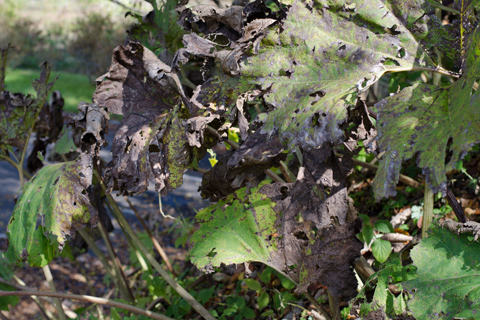
Treatment – Extensive pruning of affected areas and copper fungicides. However, there is no cure for fire blight. Removal of the tree should be considered before the pathogen spreads to neighboring trees and shrubs.
Further reading on fire blight can be found at 72tree.com/preventing-fire-blight-tree-disease/
• Diplodia Tip Blight – This disease infects conifers, first killing needles at the tips of branches. Symptoms typically appear on the lower half of the tree, progressing upwards. When new needles begin expanding, they end up stunted, turn yellow, then tan or brown.
Treatment – This pathogen responds to fungicide treatments. Treatment should start at bud break in the spring for effective control. Pruning out damaged areas, and cones should also be removed, as they hold fungal spores.
This blight can be controlled, but not cured. As with any needle blight disease, the objective of spraying the tree is to break the cycle of infection in emerging needles. Many seasons of treatments are needed before noticeable results are achieved.
• Oak Wilt – This disease infects oak trees. It can be identified as mature foliage develops a dark green water-soaked appearance, or may turn pale green or bronze, starting at the leaf margins and progressing toward the center of the leaf. This usually begins on a single branch and quickly spreads throughout the entire crown. Red oaks can die within 4 to 6 weeks after symptoms appear.
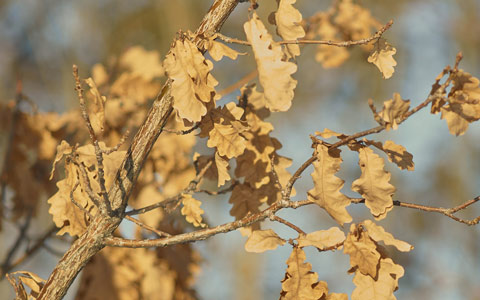
Treatment – Once an oak tree is infected with oak wilt, there is no known treatment capable of ridding the tree of the disease. Infected trees should be professionally removed.
Note: Healthy oaks can be injected with a fungicide known as Propiconazole to suppress oak wilt disease. Since Oak Wilt is spread by root grafts and insect carriers, treat those trees close to infected ones to slow the disease’s spread.
For more oak wilt information, visit 72tree.com/oak-wilt-identification-treatment-prevention/
• Dutch Elm Disease (DED) – DED is a vascular wilt disease in trees. External symptoms of infection are yellowing and wilting of leaves on individual branches. These leaves then turn brown and curl up as the branch dies, foliage eventually may drop off.
Treatment – Much like oak wilt, Dutch Elm Disease must be treated proactively before the disease is present in the tree. This disease spreads so quickly that diseased trees may not respond to any form of treatment.
Note: Healthy elms can be professionally treated in the same manner as healthy oaks with the Propiconazole fungicide.
• Canker Diseases – Symptoms may include round-to-irregular sunken, swollen, flattened, cracked, discolored, or dead areas (appearing as bruises or open wounds) on tree stems, twigs, limbs, or trunk.
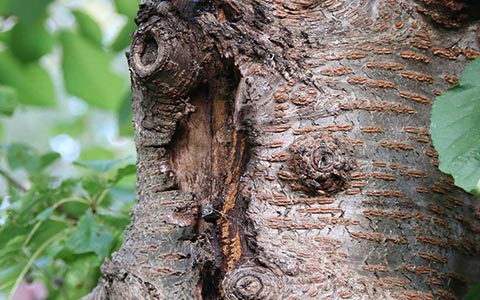
Treatment – There is no cure for canker diseases on fruit and shade trees, but the disease’s spread can be controlled by pruning out infected areas. In late winter or early spring, carefully remove and destroy infected branches 4 inches below the canker where the tree is releasing amber color sap. If the canker is located on the trunk, request professional help to treat the infected area or remove the tree.
When treating, pruning, or interacting with diseased trees, you can reduce the chances of spreading the disease by:
• Sanitizing all equipment, including gloves, rakes, saws, etc. before and after use
• Destroying (burning) dropped or pruned foliage, twigs, and limbs (never add infected material to compost piles)
• Never spraying infected trees with overhead watering or irrigation
When in doubt, don’t take the chance of making a bad tree situation worse. Reach out to an ISA certified arborist for professional help. Read more about tree fungi control and prevention at 72tree.com/how-to-get-rid-of-tree-fungi/
2. Weather-Related Tree Damage
Trees have spent millennia adapting to their climate and region. That said, severe weather can still inflict significant and sometimes lethal damages to a tree. For example:
Bark Stripping – During catastrophic weather events like tornadoes and hurricanes, bark can be stripped from a side of or from the entire tree, effectively killing it.
Impact Damage – Also, during severe weather events, yard ornaments, statues, bicycles, and even vehicles can be carried by wind or floodwater, impacting and severely damaging the tree’s bark. If enough bark is damaged or stripped from the tree, it will be girdled and quickly die.
Drought – When the weather is dry, trees still need water. Most tree roots live within the first 30-inches of soil, and without water for prolonged periods, a tree can suffer hydraulic failure and die. Proper mulching and increased watering patterns can prevent this peril.
Severe or Repeated Flooding – In contrast to drought, this can lead to the destabilization of a tree’s root plate. When this condition occurs, the tree may develop a lean or suffer windthrow from the slightest wind.
Windthrow – This condition occurs when trees are toppled by wind. When windthrow occurs, a tree is uprooted as it is blown over.
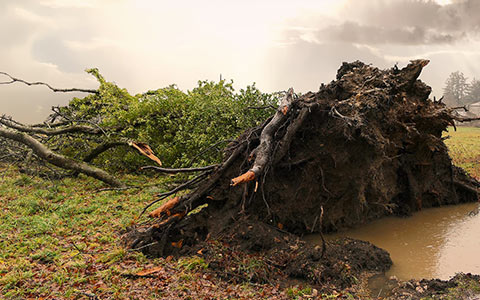
Windsnap – This condition also occurs when trees are toppled by wind. When windsnap occurs, a tree is broken off at the trunk as it is blown down. Proper seasonal pruning activities and crown thinning can significantly reduce the potential for windthrow or windsnap.
For further reading and preventative measures on windthrow and windsnap, read 72tree.com/blowndown-windthrow-windsnap/
3. Boring Insect Infestations
When it comes to tree killers, boring insects are perhaps the most prolific and persistent. Larvae feed in galleries beneath the bark, consuming the tree’s cambium layer, while adults consume the host’s foliage. Aerial views of forested land demonstrate (in large swaths) the devastation these insects are capable of. A boring insect infestation can be identified as follows:
• Adults found in traps (visual confirmation)
• Partially consumed foliage (Leaf notches)
• Chlorosis of foliage in sections of the crown
• Extreme dieback of foliage and stems
• Frass (sawdust) found on the bark from burrowing activities
• Exit holes in tree bark
• Bulging or vertical splits in the bark (over larval galleries)
• Suckers and water sprouts growing in the crown, on the trunk, and/or from the roots
• Woodpecker damage (woodpeckers hunt beetle larvae)
• Squirrel activity (some squirrel species feed on beetle larvae)
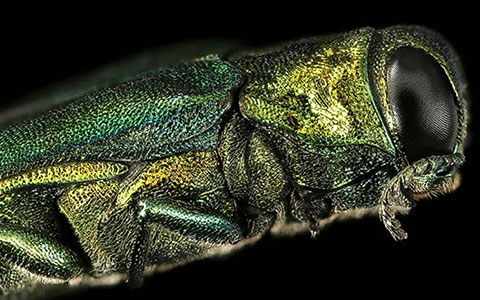
As larvae feed season after season, they channel through their host’s cambium layer in a zigzag or ribbon pattern (interrupting the flow of water and nutrients. This feeding ultimately leads to a partial or total girdling of the host, resulting in hydraulic failure and death.
Boring Insect Control and Prevention – Due to the larvae’s occult feeding activities, preventing a wood-boring insect infestation is not always possible. However, these practices will help reduce the potential of an infestation:
• Plant well-adapted species of trees not commonly attacked by wood borers in your region.
• Choose and prepare a suitable planting site to avoid tree stress like freeze damage, sunscald, windburn, and other natural stressors.
• Promote your tree’s health with proper watering, mulching, and fertilization methods.
• Use proper seasonal pruning practices (winter/dormant season).
• Avoid mechanical injury to tree trunks from lawnmowers and/or construction.
If you detect a wood-boring insect infestation, contact an ISA certified arborist to not only confirm the infestation but to mobilize local and regional forestry support if needed. Such infestations can cause catastrophic damages in very little time.
Note: In the absence of stressed or ailing trees, boring insects will attack healthy specimens.
Read more exciting literature about boring insects by visiting 72tree.com/metallic-wood-boring-beetles/
4. Lifespan of Trees
While rare, a tree can die of “old age.” However, what is considered old age for one species may be merely infancy for another. Consider the following species and their average lifespan:
• Willow (Salix) 30 years
• Birch (Betula) 40 – 50 years
• Poplar (Populus) 50 years
• Magnolia (Magnolia) 80 – 120 years
• Maple (Acer) 100 – 300 years
• Oak (Quercus) 100 – 300 years
• Ash (Fraxinus) 120 – 300 years
• Aspen (Populus tremuloides) 150 – 200 years
• Walnut (Juglans) 150 to 250 years
• Fig (Ficus carica) 200 years
• Spruce (Picea) 200 years
• Beech (Fagus) 300 – 400 years
• Elm (Ulmus) 300 years
• Pecan (Carya illinoinensis) 300 years
• Pistachio (Pistacia vera) 300 years
• Giant Sequoia (Sequoiadendron giganteum) 500 – 2,000 years
• Sycamore (Platanus occidentalis) 600 years
• Bristlecone (Balfourianae) 5,000+ years
Signs and Symptoms – Trees in decline due to age may present many symptoms, including the following:
• Chlorosis (loss of color in foliage)
• Extreme dieback (multiple dead branches)
• Cladoptosis (randomly falling branches)
• Sudden Death (the tree just dies)
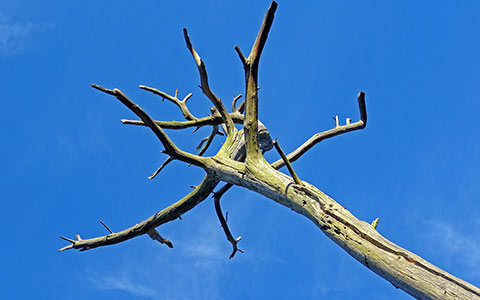
If you have a tree that is nearing or surpassing its lifespan and is in decline, there is little to nothing you can do to save it. When in these circumstances, call on an ISA certified arborist’s expertise to evaluate the tree and recommend a course of action.
Note: While most tree species can outlive a human being, the vast majority of trees succumb to weather, biological, or human interference factors long before reaching their full lifespan.
Saving Dying Trees
In this article, you discovered information about the lifespan of trees, diseases, weather, and insects that are commonly responsible for why trees die.
By taking preventative measures to halt the spread of disease and insect infestations, you are helping your tree to live up to or surpass its lifespan.
When you ignore the warning signs of a dying or sick tree, you risk suffering grave consequences when that tree dies and falls on your property.
Sources:
extension.umn.edu/plant-diseases/oak-wilt-minnesota
mortonarb.org/trees-plants/tree-and-plant-advice/help-diseases/canker-diseases
ipm.ucanr.edu/PMG/PESTNOTES/pn7414.html
fs.usda.gov/naspf/sites/default/files/publications/how_to_identify_and_manage_dutch_elm_disease.pdf
plantclinic.cornell.edu/factsheets/sphaeropsisdiplodia.pdf
